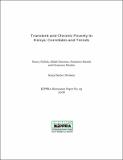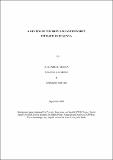Discussion Paper No. 09 of 2001 on Determinants of Poverty in Kenya: Household-Level Analysis
| dc.date.accessioned | 2021-03-03T06:57:12Z | |
| dc.date.available | 2021-03-03T06:57:12Z | |
| dc.date.issued | 2001 | |
| dc.identifier.uri | http://repository.kippra.or.ke/handle/123456789/2729 | |
| dc.description.abstract | Strategies aimed at reducing poverty need to identify factors that are strongly associated with poverty and that are amenable to modification by policy. This paper uses household-level data collected in 1994 to examine probable determinants of poverty status in Kenya, employing both binomial and polychotomous logit models of poverty analysis. The study shows that poverty status is highly correlated with the level of education, household size and type of occupational activity, and it is most prevalent in rural areas. Specifically, poverty falls as the level of education increases; it rises with household size and with engagement in agricultural activities. These effects persist in both binomial and polychotomous models used to determine poverty. In particular, extreme poverty falls rapidly as education increases and as farm households shift to non-agricultural activities. Size of landholding does not emerge as a major determinant of hard-core poverty in the sample analysed. | en |
| dc.language.iso | en | en |
| dc.publisher | The Kenya Institute for Public Policy Research and Analysis (KIPPRA) | en |
| dc.relation.ispartofseries | DP/09/2001; | |
| dc.subject | Kenya | en |
| dc.subject | Poverty determinants | en |
| dc.subject | Logit model | en |
| dc.subject | Poverty reduction | en |
| dc.title | Discussion Paper No. 09 of 2001 on Determinants of Poverty in Kenya: Household-Level Analysis | en |
| dc.type | KIPPRA Publications | en |
| ppr.contributor.author | Geda, Alemayehu ; Jong, Niek & Mwabu, Germano |
Files in this item
This item appears in the following Collection(s)
-
Discussion Papers [348]




